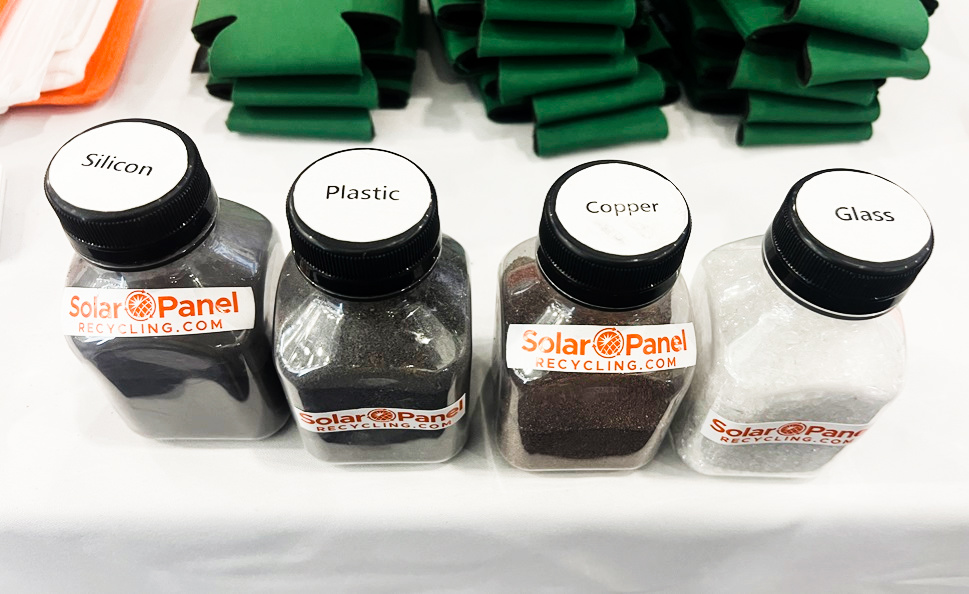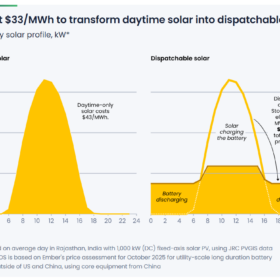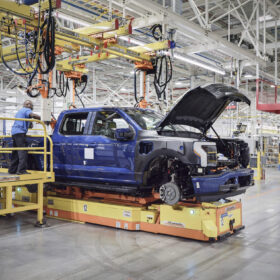For an industry centered around the sun and the clean energy it provides, recycling is a complicated story.
With many PV systems now starting to reach their end of life, there is growing concern about what happens to solar panels when they are no longer useful. Without an increase in solar recycling, the U.S. is expected to have the second largest number of decommissioned panels in the world, with as many as an estimated 10 million total tons of panels, according to the EPA.
A panel held at RE+ Northeast 2025 last week entitled “Solar End of Life or Just a Mid-Life Crisis: Repowering, Recycling and Public Policy” discussed the challenges the solar industry face as projects reach the end of life. The path to find a solution is not clear cut, or even yet foraged in many cases, but a strong will through the tough questions are often what crack ground so it may break.
The panel was moderated by Bob Nicholson, SEIA’s senior manager of sustainability and panelists included Sara Harari, director of innovation at Connecticut Green Bank; Andrew Belden, director of customer solar program at Eversource Energy; and Michelle Shiu, performance engineer at Sol Systems.
Recycling modules is the elephant in the room, Shiu said, who provided a perspective as a former manufacturing engineer who now leads Sol System’s module recycling program and other circular initiatives.
“It’s just not cost-competitive at the moment,” she said. “It’s too energy intensive to get materials back to their original state. It’s so much cheaper to just make new module materials.”
As the director of innovation at the pioneer of green banks in the U.S., Harari said Connecticut Green Bank has supported the deployment of $2.9 billion into the Connecticut clean economy since its founding in 2011, most of which is in renewables. According to Harari, the investment in more than 700 MW of renewable energy deployed in Connecticut has come from the bank.
After fueling the state with clean energy for roughly 14 years, Connecticut Green Bank’ is reflecting on the renewable energy in the rearview that it helped drive to the grid as the projects’ end of life grows closer in the horizon.
“We’re starting to think about how we started these programs ten years ago, when we look out to the future, what does that mean? For all those homeowners whose roofs we put solar onto, who’s going to bear the cost of removing the panels, and what are the associated dangers?” she asked.
As both a green bank, and the asset owner of 9.3 MW of residential solar and almost 20 MW of commercial solar, Harari said Connecticut Green Bank is thinking about the issue from both a state policy perspective and for the bank’s portfolio of assets.
“We’re thinking, ‘How do we maintain our mission of being a good for the environment, finding solutions and not landfilling, which is the cheapest option?” she said.
One solution Harari proposed is extended producer responsibility (EPR).
EPR programs require the manufacturer (or other identified party, such as a distributor) to manage the solar modules’ takeback and recycling.
“It’s essentially the idea that whoever puts the material into the market is the one that is responsible for dealing with it, reclaiming it, covering the cost of it for the end of its useful life,” Harari said.
Policy
Federally, solar modules are considered hazardous waste, while policies that require recycling or reuse of components are scattered among U.S. states.
According to the Solar Energy Industries Association (SEIA), only a few states had policies requiring recycling or reuse of components at the time of decommissioning or end of life as of 2024. However, some states have enacted legislation related to waste characterization for solar panels to be recycled, while other states have varying requirements. Maine, for example, requires any recyclable solar components to be recycled by an authorized facility.
One of SEIA’s biggest challenges is how very inconsistent requirements are between states, said Nicholson.
“The truth is that not many states or municipalities have figured it out yet,” Harari said, “I think that makes sense because Connecticut was sort of one of the early adopters of behind the meter solar programs. So, it makes sense that we would be a sort of Vanguard of having to figure out what happens at the end of life for those assets.”
Harari said solving this challenge requires collective action across not only regional groups, but across industries as well.
“You need a collective solution across the Northeast with all of the different states that are working on this topic together,” she said, “especially regional action, especially here in the northeast,” adding, “We don’t have any solar recycling manufacturing facilities located in the Northeast.”
“A big lesson for me coming out of this was that energy people are thinking about energy products, waste people are thinking about waste streams and waste processing,” Harari said, “but the waste people are not here at RE+, and we are not going to the waste conferences where they’re talking about waste solutions,” she said.
To Belden, the solution lies across a number of policy perspectives. This includes working out a policy that encourages reusing components if they are in working order instead of recycling them.
They may be on the back side of the power purchase agreement with their local government, and the energy markets and rates that are available may have changed significantly, he said.
“If we want to continue to maintain these sites into 30 to 50 years and not lose ground, then that’s a policy conversation that we all need to start having and thinking about,” he said, “and it’s going to be asked sooner rather than later.”
When asked whether Connecticut Green Bank found success from refurbishing solar panels for replacement, Harari said she “would say it’s more of an experiment than a success.”
“Some of our residential panels that have had warranty challenges with them. The same with our commercial systems,” Harari said. “It has been complicated and expensive to figure that out,” she said, “We’re trying everything we can that’s available in the market right now.”
Based on the refurbished panels that Connecticut Green Bank sent back in operation, Harari said, “One of the big challenges that we see with refurbishment is erosion of warranty,” she said. “If the panels are no longer covered by the original warranty, now that they have been refurbished, who then bears the risk of failure?”
For more on solar module recycling, read Solar panel recycling: Demand, technology and supply chain and Saving the U.S. solar panel recycling market.
This content is protected by copyright and may not be reused. If you want to cooperate with us and would like to reuse some of our content, please contact: editors@pv-magazine.com.









By submitting this form you agree to pv magazine using your data for the purposes of publishing your comment.
Your personal data will only be disclosed or otherwise transmitted to third parties for the purposes of spam filtering or if this is necessary for technical maintenance of the website. Any other transfer to third parties will not take place unless this is justified on the basis of applicable data protection regulations or if pv magazine is legally obliged to do so.
You may revoke this consent at any time with effect for the future, in which case your personal data will be deleted immediately. Otherwise, your data will be deleted if pv magazine has processed your request or the purpose of data storage is fulfilled.
Further information on data privacy can be found in our Data Protection Policy.